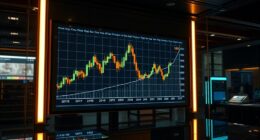Trading bots are automated software programs that execute trades for you in financial markets. They rely on predefined algorithms to analyze market data and react quickly to price changes, operating 24/7 without the emotional influences of human traders. You can find different types, like arbitrage or trend-following bots, each designed for specific trading strategies. While trading bots offer greater efficiency and can capitalize on fleeting opportunities, they also come with risks such as technical failures and market volatility. If you're curious about how these bots can enhance your trading experience, there's plenty more to uncover.
Key Takeaways
- Trading bots are automated software programs that execute trades based on predefined algorithms and market strategies.
- They operate 24/7 to capitalize on market opportunities and price fluctuations without human intervention.
- Trading bots analyze vast amounts of market data swiftly, identifying trends and optimizing trade execution.
- They can backtest strategies using historical data to refine performance before live trading.
- While offering efficiency, trading bots also carry risks such as market volatility and programming errors.
Fundamental Concepts of Trading Bots

Trading bots are revolutionizing the way traders engage with the market. These automated trading systems use predefined algorithms and market indicators to execute trades without human intervention.
With the ability to operate 24/7, trading bots capitalize on market opportunities and react swiftly to price fluctuations. Different types of bots, like arbitrage, market-making, trend-following, and scalping, cater to specific trading strategies, enhancing your decision-making process.
By connecting to cryptocurrency exchanges via APIs, they ensure optimal timing and price execution. However, be mindful of risks such as market volatility, technical failures, and potential programming errors.
Understanding these fundamental concepts helps you leverage algorithmic trading effectively while navigating the complexities of the market.
Overview of Trading Bots

Automated software programs, known as trading bots, are transforming how traders approach financial markets.
These bots execute trades based on predefined algorithms and trading strategies, allowing you to trade around the clock without human intervention. They analyze market data swiftly, identifying trends and capitalizing on price fluctuations across various asset classes, including cryptocurrency.
Different types of trading bots, like scalping bots, use specific strategies to optimize outcomes. Additionally, trading bots can backtest strategies with historical data, refining their performance before live trading.
While they enhance efficiency and reduce emotional decision-making, it's essential to recognize the risks involved, such as market volatility and potential technical failures, especially when accessing user funds.
Algorithmic Trading Execution Process
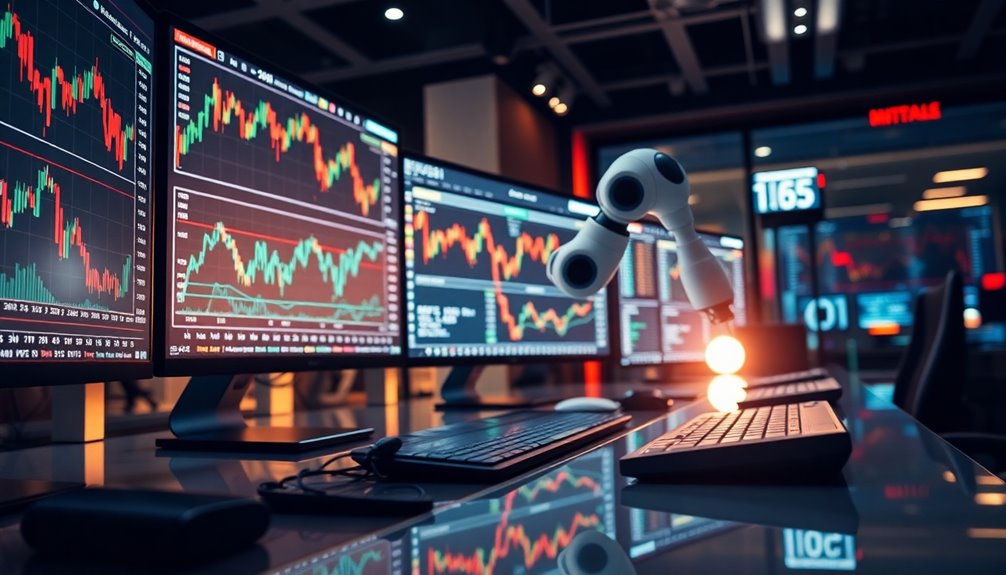
As you delve into the algorithmic trading execution process, you'll discover how trading bots leverage predefined algorithms to analyze market data and execute trades seamlessly.
These bots connect to cryptocurrency exchanges through Application Programming Interfaces (APIs), allowing them to place trades in real-time without human intervention. They process vast amounts of data in milliseconds, crucial for reacting to price movements in volatile markets.
Many trading bots also offer backtesting capabilities, enabling you to evaluate trading strategies based on historical data before going live.
This execution process can be tailored to various strategies, such as arbitrage, market making, or trend following, helping you meet your specific trading goals and risk appetites.
Pros and Cons Summary
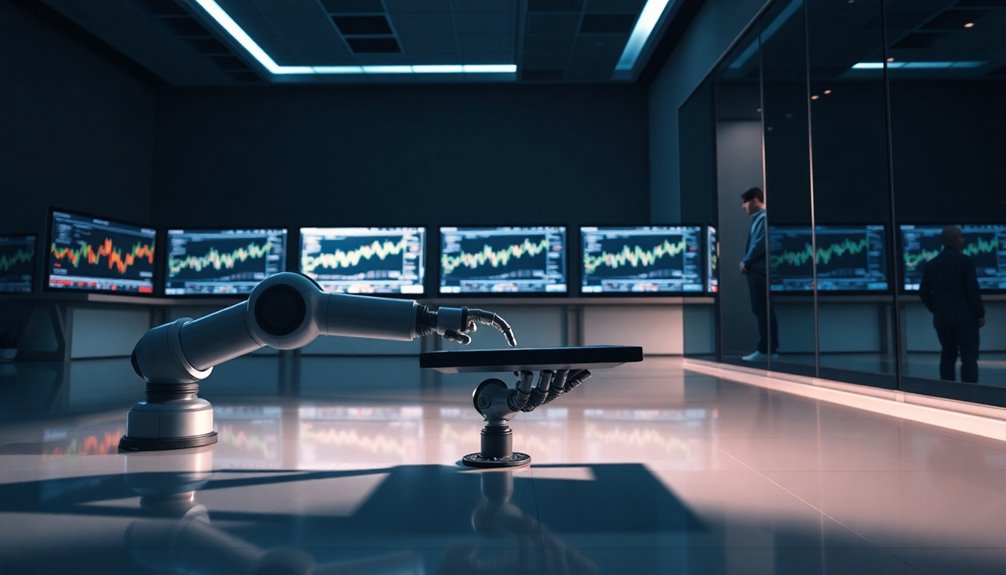
How do trading bots stack up in terms of benefits and drawbacks?
On the plus side, trading bots enable automated trading 24/7, allowing you to seize trading opportunities without constant oversight. They help eliminate emotional decision-making, leading to more disciplined trading based on predefined strategies.
However, there are notable downsides. If market conditions shift unexpectedly or if there's a flaw in the bot's programming, you could face significant losses. Technical issues or software bugs may disrupt operations, making performance monitoring crucial.
Additionally, regulatory risks and security vulnerabilities associated with third-party bots could expose you to scams or loss of funds.
Weighing these pros and cons can help you decide if trading bots are right for your trading strategy.
Bot Performance Versus Manual Trading

While both trading bots and manual trading have their merits, the differences in performance can be striking.
Trading bots excel in high-frequency environments, executing trades at speeds and volumes that manual trading simply can't match. They capitalize on fleeting market fluctuations and make informed trading decisions by continuously analyzing multiple data points. This leads to increased trading efficiency and volume, often resulting in consistent profits.
In contrast, manual trading requires constant market monitoring, which can lead to fatigue and emotional decision-making errors. With bots operating 24/7, they ensure you never miss a trading opportunity, allowing you to focus on strategy rather than constant screen time.
Ultimately, algorithmic trading offers a competitive edge that's hard to ignore.
Market Volatility Impacts Performance
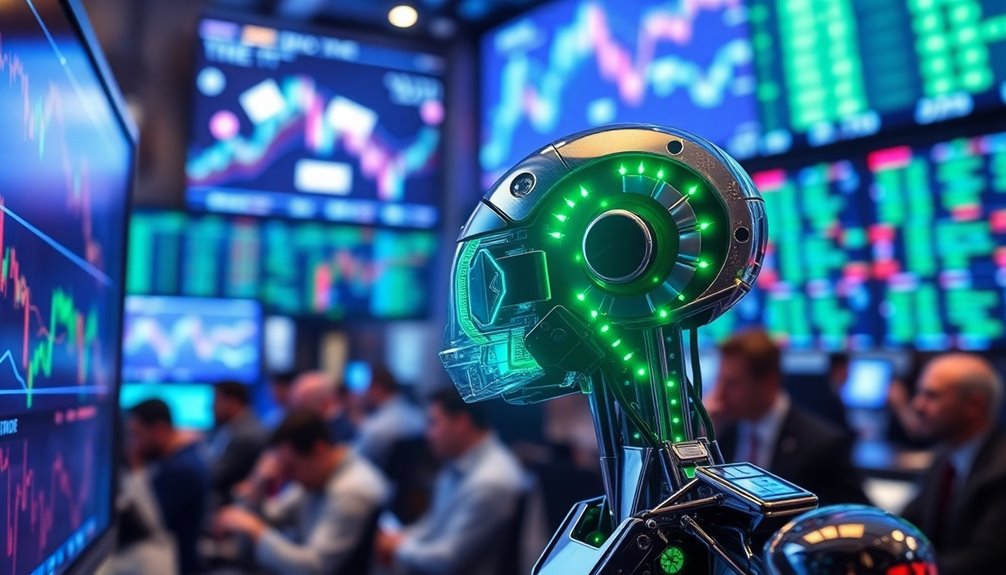
Market volatility significantly impacts the performance of trading bots, making it essential for users to understand how these fluctuations can affect their strategies.
When asset prices experience significant changes, bots that rely on stable patterns might face unexpected losses. For instance, trend-following strategies can struggle as abrupt price movements disrupt established trends, leading to poor trade decisions.
Similarly, arbitrage bots may see reduced opportunities during high volatility, as quick price discrepancies can diminish potential profits.
To maintain optimal trading performance, continuous monitoring and adjustments to trading strategies are crucial. By staying aware of market conditions, you can better prepare your trading bots to adapt and minimize risks associated with volatility.
AI Integration in Trading Bots
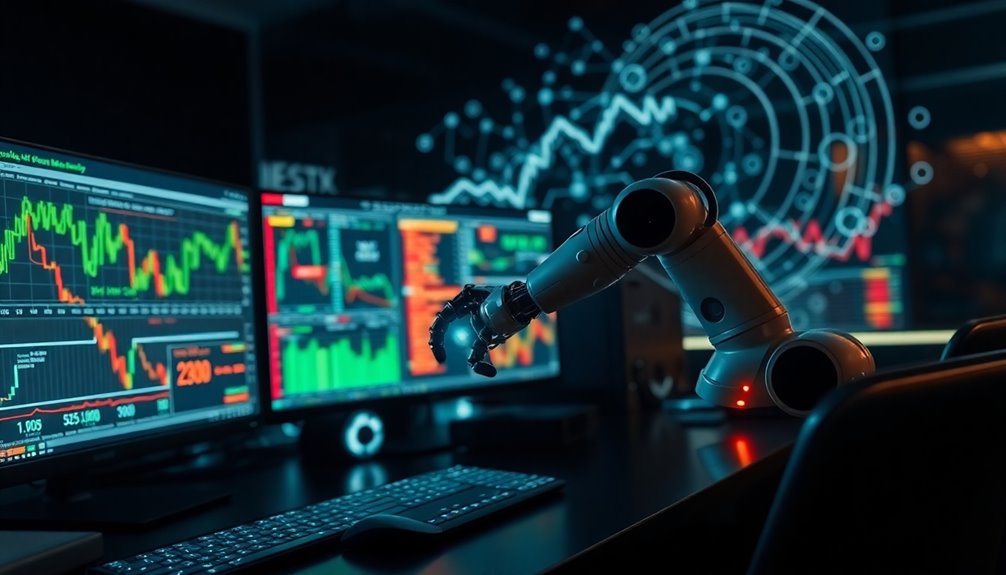
Amidst the challenges posed by market volatility, AI integration in trading bots offers a powerful solution to enhance trading effectiveness.
These advanced trading bots analyze vast amounts of market data in real-time, enabling you to make more informed decisions based on predictive analytics. With machine learning, they adapt to changing conditions, improving trading strategies over time.
AI-driven bots can uncover complex patterns and correlations, potentially boosting profitability beyond traditional methods. By utilizing natural language processing, they also assess news articles and social media sentiment, providing valuable insights into market trends.
Furthermore, automated risk management tools help dynamically adjust your strategies based on volatility and fluctuations, ensuring you're better equipped to navigate the ever-changing market landscape.
Set Clear Trading Goals

Setting clear trading goals is essential for navigating the complexities of the financial market effectively. By defining your risk tolerance and profit expectations, you can make better decisions when using a trading bot.
Aim for specific, measurable trading goals, like achieving a certain percentage return each month or limiting losses to a fixed amount. This clarity helps you configure trading parameters and select the right bot for your specific strategies, whether they involve short-term or long-term investing.
Establish a timeline for your goals and regularly review performance metrics to adjust your strategies based on changing market conditions. This way, you'll optimize your trading bot's effectiveness and stay aligned with your evolving objectives.
Frequently Asked Questions
What Do Trading Bots Do?
When you use trading bots, they analyze market data and execute trades based on algorithms.
You can set specific strategies, like trend following or scalping, to capitalize on market opportunities. These bots operate continuously, reacting to price movements faster than you might.
Are Trading Bots Legal?
Are trading bots legal? Yes, they're legal in many places, but you need to check your local regulations.
In the U.S., for instance, you've got to comply with SEC and FINRA rules to ensure fair practices. Some countries impose restrictions, so it's crucial to understand those laws before using one.
Also, make sure your bot follows the exchange's terms of service to avoid account issues. You're ultimately responsible for your bot's actions.
Is Trading Bot Profitable?
You might find trading bots profitable, but it really depends on their algorithms and strategies. Some bots can generate impressive returns in optimal conditions, while others may lead to losses due to market volatility.
How Much Do Trading Bots Cost?
The cost of trading bots can really vary. You might find basic bots for free, while advanced ones can range from $20 to thousands of dollars.
Subscription models often charge between $10 and $100 monthly, with some premium options hitting up to $1,000 annually.
You can also buy some systems outright, like the 1000pip Climber System for around $97.
Many offer free trials, so you can test them before spending any money.
Conclusion
In conclusion, trading bots can be powerful tools for your trading strategy, offering speed and efficiency that manual trading often can't match. However, it's crucial to weigh their pros and cons and understand how market volatility can impact performance. By integrating AI and setting clear trading goals, you can enhance your chances of success. Ultimately, whether you choose a bot or stick to manual trading, staying informed and adaptable will be key to your trading journey.









